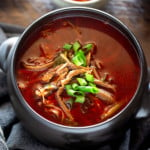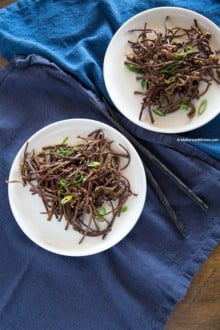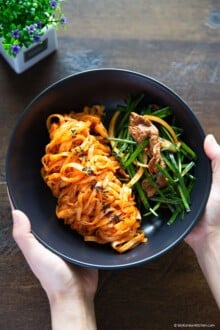Hearty and comforting yukgaejang recipe. This spicy beef soup is made slowly in a traditional way to bring out all the delicious flavor in depth. Learn how to make this at home!
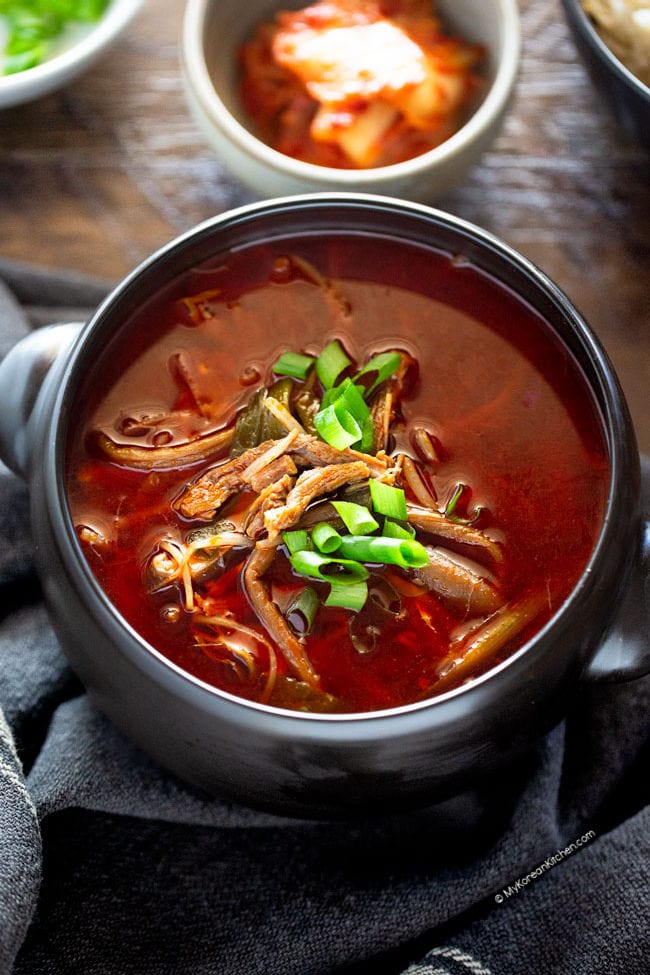
What is Yukgaejang
Yukgaejang (yuk gae jang, 육개장) is Korean spicy beef soup. It is often served during hot summer days as a stamina food. But due to the hearty nature of the soup, it is commonly served during colder months as a comfort food.
The soup highlights shredded beef brisket, water, fernbrake (bracken fiddlehead), bean sprouts, green onions, sesame oil and Korean chili powder as an integral ingredients.
The soup is slightly spicy, savory, and comforting. You will also taste earthy flavor from the fernbrake and shiitake mushrooms.
Yukgaejang is served with a bowl of rice, kimchi and other Korean side dishes. But really, you won’t find the need to prepare other side dishes as yukgaejang itself is quite substantial. A good balance of meat and vegetables!
The spicy soup looks fiery and bold but it is not crazy spicy unless you make it that way. So don’t get intimidated by it!
Ingredient Substitutions and Tips
Meat
Typically you make yukgaejang with beef brisket, but flank steak and shank steak is also a possible cut you could use.
Some people also use chicken instead of beef. In this case, the name of the soup will change to dakgaejang (닭개장); Dak means chicken.
Fernbrake
As I mentioned briefly above fernbrake (gosari, 고사리) adds earthy taste and also meaty texture.
You can buy fernbrake in a dried format or frozen format. If you buy a dried version, you will have to soak them overnight (about 8 hours) to rehydrate then boil them over medium high heat for about 40 mins. Then, drain and rinse the fernbrake and soak them in cold water for about 30 mins. (Soaking in cold water can be skipped if you are short of time.) Now, it is ready to use.
50g (1.8 ounces) of dried fernbrake results in about 300g (10.6 ounces) of hydrated fernbrake. You can portion the hydrated fernbrake in a ziplock bag and freeze for later use.
If you buy frozen fernbrakes (available from a Korean grocer), they are ready to use as it is hydrated and pre-boiled. Just note that this is more expensive than the dried fernbrake.
If you don’t have any access to fernbrake, you can add more shiitake mushrooms and green onions. Fernbrake is hard to substitute, but these two can help bring out more earthy taste.
Bean Sprouts
Bean sprouts add a nice crunchy texture and add refreshing taste. But if you add excessively, it can dilute the overall soup taste as it releases water while cooking. So add these in moderation.
Korean Chili Oil
Do you love spicy soup? Or do you just want to add some fiery and bold red look to your soup to make it even more appetizing? If so, add some Korean chili oil.
You can buy a bottle from a Korean grocer or you can easily make it at home using this chili oil recipe.
While Korean chili powder provides a bit of redness and also spiciness, if you add some chili oil, it enhances the redness of the soup and also increases the spice level without making the soup too powdery. (If you add chili powder too much, it can make the soup a bit grainy.)
Others
Other ingredients that can be added in your yukgaejang are beaten eggs and glass noodles (dangmyeon). I don’t like adding them personally, but you can add them if you like. You can add them about 5 mins before finishing boiling the soup.
Glass noodles should be soaked in water for 30 to 40 mins before you add them into the soup. Also, note that glass noodles don’t store well. It swells and breaks easily. It is best to consume the glass noodles on the day of making it if you add them.
How to Store Yukgaejang
If you made more soup than you need for one meal, you can refrigerate the soup in an air tight container. It should be good for 3 to 4 days. If you want to store it for longer, you can divide the soup into smaller portions and freeze. To use, defrost the soup in the fridge overnight and reheat as you need it.
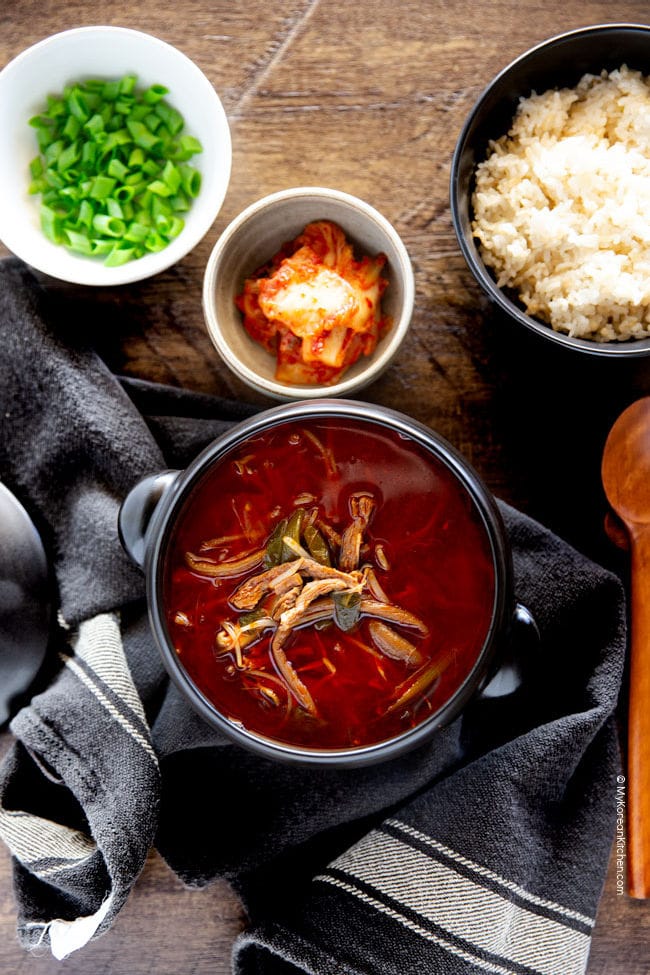
Other Korean Soup Recipes You Might Like To Try
- Galbitang (Beef Short Rib Soup)
- Sundubu Jjigae (Spicy Soft Tofu Stew)
- Slow Cooker Kimchi Beef Stew
Ingredients for Yukgaejang
Beef Broth
- 10 cups water
- 350g / 12 ounces beef brisket, or flank steak, shank steak
- 1 onion (260g / 9 ounces), cut in half
- 2 green onions, white part
- 1 tsp black peppercorn, whole
Main
- 1 Tbsp cooking oil (I used rice bran oil)
- 3 Tbsp sesame oil
- 75g / 2.6 ounces green onion, cut it in about half to divide the white and green part. Then halve the pieces (white and green) lengthwise and then cut into 4 cm to 5 cm (1.5 inch to 2 inch) pieces
- 3 Tbsp Korean chili powder (preferred) or Korean chili flakes, gochugaru
- 95g / 3.3 ounces shiitake mushrooms, fresh, thinly sliced
- 100g / 3.5 ounces hydrated gosari (fernbrake), cut into 4 cm to 5 cm, refer to my cooking tips above
- 2 Tbsp Korean chili oil (optional)
- 200g / 7 ounces bean sprouts
Seasonings
- 2 Tbsp Korean soup soy sauce (gukganjang)
- 1 Tbsp Korean fish sauce (or Korean soup soy sauce)
- 1/2 Tbsp minced garlic
- 1/2 tsp fine sea salt
- 1/8 tsp ground black pepper
Garnish
- 10g / 0.4 ounces green onion, thinly sliced
- fine sea salt, to taste
*1 Tbsp = 15 ml, 1 cup = 250 ml
** If you want to learn more about Korean ingredients, check my essential Korean ingredients list.
How to Make Yukgaejang
1. Soak the brisket in a bowl of water and set aside for 20 minutes to draw the red liquid (myoglobin) out. Change the water a few times during this time.
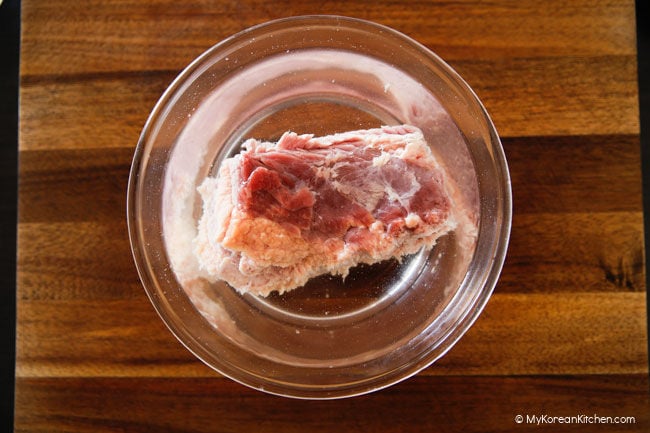
2. Add the water (10 cups), brisket, onion, green onions and whole black peppercorns into a large pot. Boil them over high heat (for about 15 mins) and skim off any scum that forms. Once the water starts to rolling boil, cover the pot with the lid and reduce the heat to medium low. Continue boiling for another 45 mins. This should give you about 7.5 cups to 8 cups of broth.
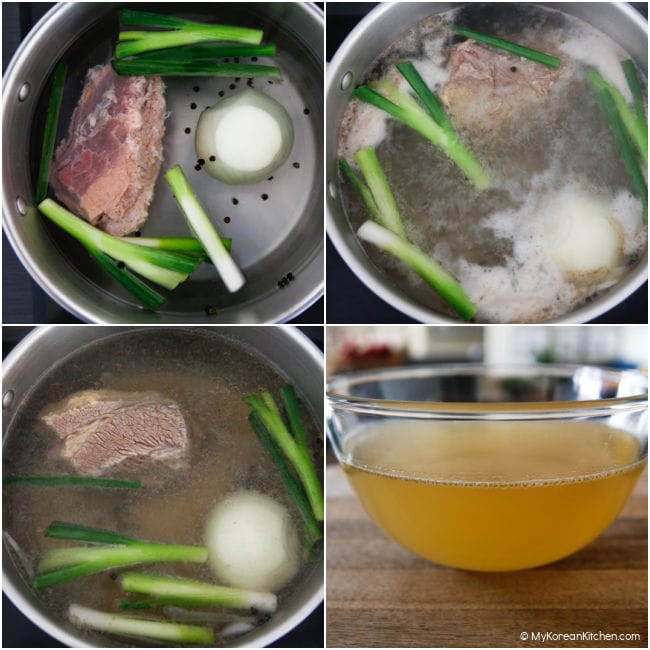
3. Take the meat out onto a plate and cool it down. Strain the remaining ingredients over a large clean bowl. Discard all the strained vegetables while keeping the broth. Once the meat is cool enough to touch, cut off any stringy fat and shred or cut the brisket into small thin strips.
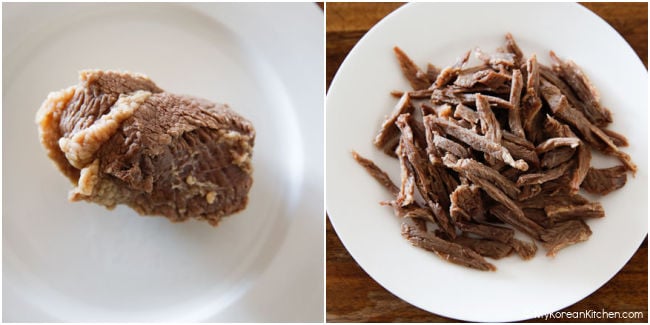
4. Preheat a large clean pot over medium low heat and once heated, add the cooking oil, sesame oil, green onions and stir.

5. Once the green onions are wilted, add the chili powder and stir for about 30 seconds or until the chili powder absorbs all the oils. Make sure you don’t burn the chili powder as it can easily happen.

6. Add the broth (from step 3), the meat, and shiitake mushrooms into the pot and boil them over medium high heat. Once it’s rolling boiling, add the fernbrake, chili oil, and seasonings and reduce the heat to medium. Cover the pot with the lid and boil them for about 30 minutes.
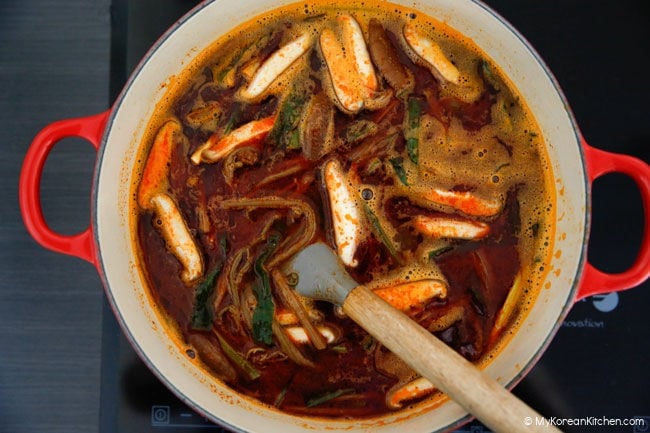
7. Add bean sprouts and boil for a further 10 mins.
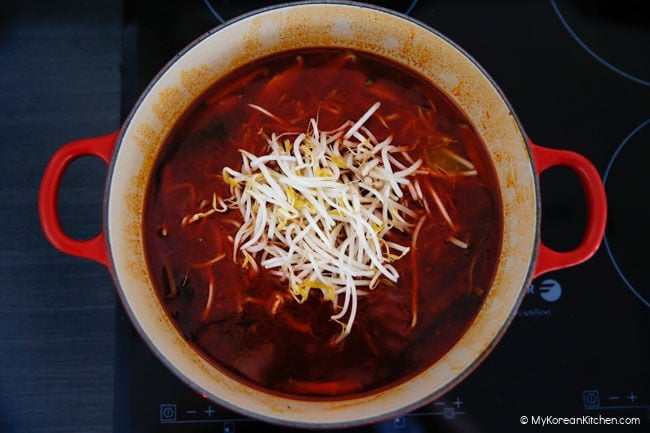
8. Garnish with green onions and season with salt if required. Serve with a bowl of rice, kimchi and other Korean side dishes.
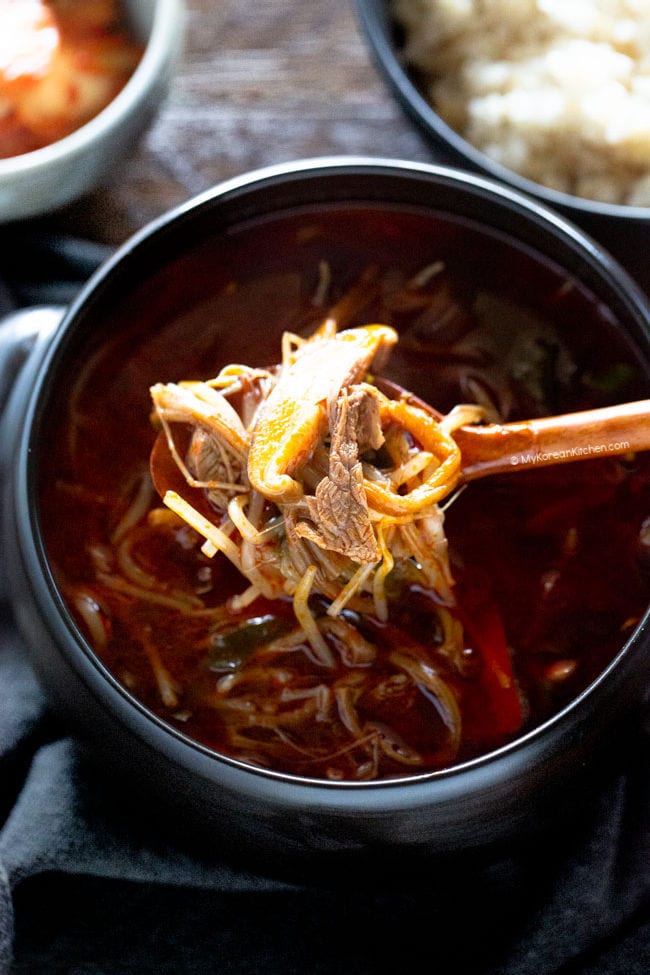
Love Korean food? Browse lots more Korean recipes from my easy Korean recipe collections. And subscribe to my newsletter and follow along on Facebook, Pinterest and Instagram for all of the latest updates.
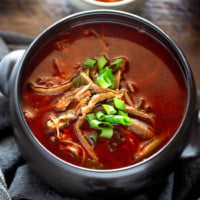
Yukgaejang (Korean Spicy Beef Soup)
Ingredients
BEEF BROTH
- 10 cups water
- 350 g beef brisket (12 ounces) or flank steak, shank steak
- 1 onion (260g / 9 ounces), cut in half
- 75 g green onions (2.6 ounces), cut it in about half to divide the white and green part. Then halve the pieces (white and green) lengthwise and then cut into 4 cm to 5 cm (1.5 inch to 2 inch) pieces
- 1 tsp black peppercorn , whole
MAIN
- 1 Tbsp cooking oil (I used rice bran oil)
- 3 Tbsp sesame oil
- 75 g green onion (2.6 ounces)
- 3 Tbsp Korean chili powder, (preferred) or Korean chili flakes, gochugaru
- 95 g shiitake mushrooms (3.3 ounces), fresh, thinly sliced
- 100 g hydrated gosari (fernbrake), (3.5 ounces), cut into 4 cm to 5 cm, refer to my cooking tips above
- 2 Tbsp Korean chili oil (optional)
- 200 g bean sprouts (7 ounces)
SEASONINGS
- 2 Tbsp Korean soup soy sauce (gukganjang)
- 1 Tbsp Korean fish sauce (or Korean soup soy sauce)
- 1/2 Tbsp minced garlic
- 1/2 tsp fine sea salt
- 1/8 tsp ground black pepper
GARNISH
- 10 g green onion (0.4 ounces), thinly sliced
- fine sea salt , to taste
Instructions
- Soak the brisket in a bowl of water and set aside for 20 minutes to draw the red liquid (myoglobin) out. Change the water a few times during this time.
- Add the water (10 cups), brisket, onion, green onions and whole black peppercorns into a large pot. Boil them over high heat (for about 15 mins) and skim off any scum that forms. Once the water starts to rolling boil, cover the pot with the lid and reduce the heat to medium low. Continue boiling for another 45 mins. This should give you about 7.5 cups to 8 cups of broth.
- Take the meat out onto a plate and cool it down. Strain the remaining ingredients over a large clean bowl. Discard all the strained vegetables while keeping the broth. Once the meat is cool enough to touch, cut off any stringy fat and shred or cut the brisket into small thin strips.
- Preheat a large clean pot over medium low heat and once heated, add the cooking oil, sesame oil, green onions and stir.
- Once the green onions are wilted, add the chili powder and stir for about 30 seconds or until the chili powder absorbs all the oils. Make sure you don’t burn the chili powder as it can easily happen.
- Add the broth (from step 3), the meat, and shiitake mushrooms into the pot and boil them over medium high heat. Once it’s rolling boiling, add the fernbrake, chili oil, and seasonings and reduce the heat to medium. Cover the pot with the lid and boil them for about 30 minutes.
- Add bean sprouts and boil for a further 10 mins.
- Garnish with green onions and season with salt if required. Serve with a bowl of rice, kimchi and other Korean side dishes.
Notes
Nutrition Info (per serving)
The nutrition information shown is an estimate provided by an online nutrition calculator. It should not be considered a substitute for a professional nutritionist’s advice.
